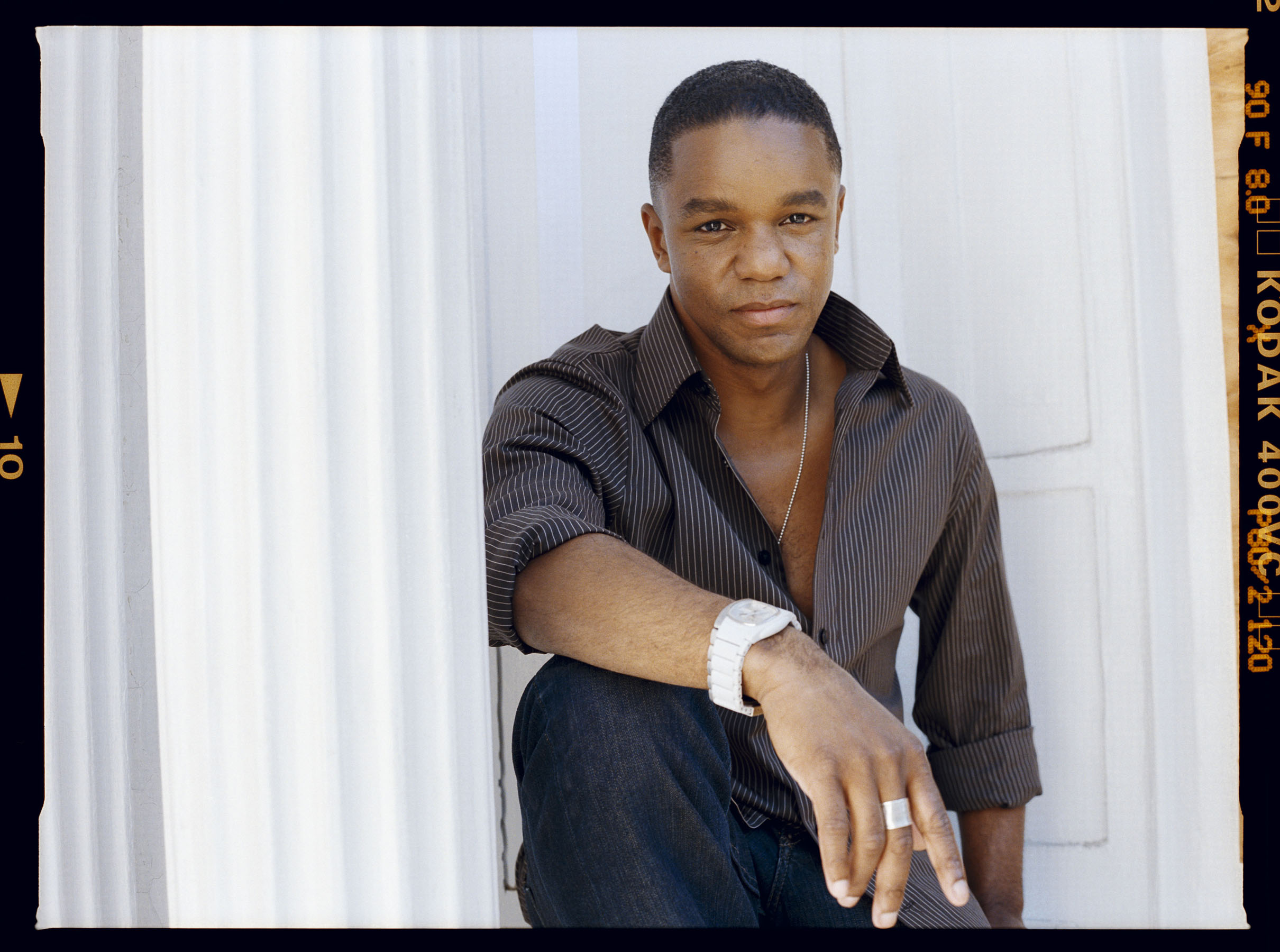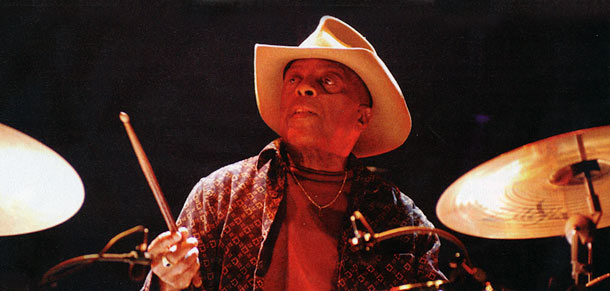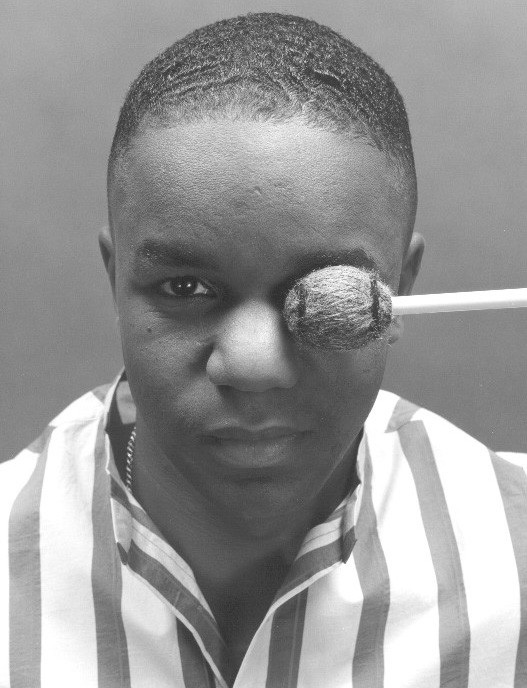
 Stefon Harris |
 Roy Haynes |
|
By Jean Timmons Recently, Roy Haynes and Stefon Harris, each with his own group, performed at Symphony Center. Both musicians exuded confidence. In Harris, it manifested in the quick movements of a playful young man; in Haynes, it was in his supreme cool and wariness before jumping into action.Harris took the stage first with his chamber jazz ensemble of eight musicians and a program titled “African Tarantella . . . Dances with Duke.” As he walked on and acknowledged the audience, the ensemble tuned up as if readying for a classical performance. In his opening comments to the audience, Harris remarked about being torn between becoming a classical or jazz musician. His selection of musicians tonight attested to the dilemma, which, judging by their performance, was resolved satisfactorily. Twenty-two-year-old Earl Travis on bass was remarkable, as was Terreon Gully on drums; Mark Vinci (wearing a yellow sports jacket) played a joyous clarinet; Roland Barber on trombone could play sad-like and sly, reminiscent of Vic Dickerson; and Anne Drummond on flute, Junah Chung on viola, and Louise Dubin on cello all had their singular moments. Finally pianist Xavier Davis conjured the memory of the Duke and his playing, but how could he not given a program that showcased Duke Ellington’s music and some original Harris compositions. Harris has commented on his attraction to the Duke: “I think it’s very apropos that someone of my generation would embrace an icon like Ellington. . . . His legacy provides us with a clear sense of pride and tradition” (program notes). 
Before wrapping up his talk with the audience, Harris seemed unable to stop himself from telling everyone that he was happy. And from the onset, his music reflected positive energy. Recall Lionel Hampton on the classic “Flying Home.” He was a monster and he played mainly in the upper register. Hamp could really swing. Stefon suggested that high energy, too; and while it seemed less energetic, it was more muscular. Harris’ actions are always patently aggressive, yet his music is so sweet. It’s really magical, the way Stefon produces music. Perhaps he ranges further in the sounds he produces than Hamp, but one was reminded of the grand master when Harris would vocalize to help him make his instrument sing. They performed five pieces. The first selection was “Thanks for the Beautiful Land of the Delta” from Ellington’s New Orleans Suite, which set a tone of inventiveness. The second was “Sunset and the Mockingbird,” which was more a blues in the piano opening. In this piece, the twenty-two-year-old bass player took a solo that set off murmurings in the audience. The clarinetist took a solo as well, which made me wonder about his background. He didn’t swing easily. The third piece, “Dances with Duke,” was fast and melodic; and on this one, in particular, it became apparent that Harris himself was even more assured than he was the last time I saw him. “Dances” was initiated by a Harris solo long enough to establish a meditative groove, and then the drummer, with whom he was very simpatico on all selections, kicked in marvelously. The pianist smoothly joined them, along with the bass. Suddenly, the flute came riding in high to add surprise and variation. Finally a haunting trombone solo slipped into the piece, supported with a nice rhythm provided by the other musicians. Quite a lovely piece. Then they launched an original Harris composition that included a few Charlie Parker licks titled “Memoirs of a Frozen Summer.” According to Harris, the piece was “derived from personal reflections about the beginning of my transition into the world of jazz.” The final selection, from the CD African Tarantella, created a very percussive air, with its hard drums opening, which was later softened here and there by the wind instruments. The violin and cello were very active. This piece of music blended classical and jazz ideas. The stately cello set against the sly trombone, enhanced with a mute—Vic Dickerson lives. The musicians enjoyed each other. Great bass solo. Drummer steady throughout. Harris, the happy golden striker. Roy Haynes’ concert was titled “Fountain of Youth,” and the 82-year-old drummer must have discovered some age-defying elixir to perform as he did this evening. When Haynes arrived on stage, the audience was primed, but not to hear that Marcus Strickland could not play and that Jaleel Shaw would replace him on saxophone. But that disappointment was short-lived. The other members of Haynes’ Quartet were present: Martin Bejerano on piano and David Wong on bass. This group of musicians was even more casually dressed than Stefon’s group. Roy wore gym shoes. As if to complement their appearances, the music started off very upbeat, with the saxophonist plunging ahead. The pianist was almost rushing. Nice piano solo; adequate bass. Haynes came in at the end and took over. But, at the beginning of the second piece, Haynes left the stage. He just casually walked off, stage left.  During his absence, the second piece opened with a piano solo. But then, as one began to grow disruptively curious about his whereabouts, recalling the stage antics of Miles Davis that became jazz history, Haynes suddenly appeared at the back of the stage, next to the bass player, swaying in time with music that I couldn’t identify. It definitely borrowed from Sonny Rollins’ “Sonnymoon for Two.” Similar, in attitude, to the mysterious disappearance, Haynes didn’t identify the pieces they performed, as if the music would announce itself. And it certainly was protean enough to keep the audience alert to the changes. At one point, Shaw picked up his soprano sax with which he delivered a very dynamic solo. When Haynes rejoined the group to take the music into familiar “Sonnymoon” territory, Wong had really gotten on top of it with some really nice bass work.
During his absence, the second piece opened with a piano solo. But then, as one began to grow disruptively curious about his whereabouts, recalling the stage antics of Miles Davis that became jazz history, Haynes suddenly appeared at the back of the stage, next to the bass player, swaying in time with music that I couldn’t identify. It definitely borrowed from Sonny Rollins’ “Sonnymoon for Two.” Similar, in attitude, to the mysterious disappearance, Haynes didn’t identify the pieces they performed, as if the music would announce itself. And it certainly was protean enough to keep the audience alert to the changes. At one point, Shaw picked up his soprano sax with which he delivered a very dynamic solo. When Haynes rejoined the group to take the music into familiar “Sonnymoon” territory, Wong had really gotten on top of it with some really nice bass work.
By the time they began the third piece, “My Heart Belongs to Daddy,” all was in order. (Although whatever else happened, Haynes brought his excellent sense of time and all-inclusive sound to every piece.) The chief element of “Daddy” was the interplay of piano and drums, with Haynes riding the cymbals. Haynes kicked it off and Bejerano accompanied with nice, minimal piano. The saxophonist, mouthpiece sparkling as he worked out his part, interposed the lyrics precisely, until the drummer picked up the tempo. Still the music tugged at one’s emotions in spite of its calypso beat. The musicians really pushed each other. At the end, after a tremendous crescendo, Haynes left the drums to walk around tapping his sticks together, making more music. If Haynes bemoans any youthful indiscretions, he must have exorcised them in working through the fourth piece of music—“Blame It on My Youth.” The brushwork paced this one. After the great sax opening, which left room for a great piano opening, the brushes and the steady bass made everything right with the world. Definitely “Blame It on My Youth” was but beautiful. The fifth and final piece was launched with a long solo movement by Haynes to wrap it up. It was pyrotechnics time; Haynes even changed sticks. The bassist certainly had to move to keep up with Roy. This one also sounded like a Rollins-influenced piece of music. And throughout this drum-dominated piece, he never “banged;” he always carried a tune. Haynes played with excellent musicians tonight, and they served to remind me of his longevity. To get a deeper feeling of an aspect of his playing now, listen to him on the John Coltrane Dear Old Stockholm CD, particularly on the title cut with just him and the Trane. At that time, Coltrane’s regular drummer, Elvin Jones, had to take some time away from the group and Haynes replaced him. On that occasion in his life, he played with the Master and he, though challenged, held his own. Tonight, he was a Master and the other musicians were challenged to keep up with him. Long may he live . . . |